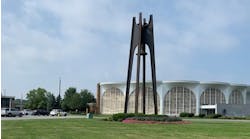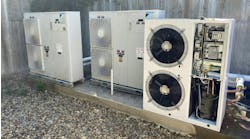THREE YEARS AGO, The U.S Department of Energy's Office of Energy Efficiency and Renewable Energy and the National Renewable Energy Laboratory teamed up to create a contest whereby some of the world's brightest architectural and engineering students could come together and demonstrate futuristic homes on the National Mall in Washington.
A total of 14 teams were assembled from colleges across the United States and as far away as Puerto Rico. The students and their advisers/professors were given a stringent set of criteria to which the dwellings had to conform. Among them, the homes had to derive all the heating, cooling, lighting and water heating energy from the sun. The homes had to be occupied during the contest. An electric car, which was charged from the home's energy plant, had to be driven a minimum amount of miles, with additional mileage credits given beyond those minimum miles.
The students were required to demonstrate communication skills through the development of interactive Websites, and computers were on in each home allowing visitors access to the students' individual Decathlon Websites during the contest. The students were required to treat their own water, as well as pressurizing it for their own use. All the energy required to do this was derived from the home's solar power system.
Although the criteria for the contest were distributed to the contestants during-the previous year, construction and shipment of the homes didn't occur until the summer of 2002, the last time this competition was held. (The Solar Decathlon is held every three years.) One of the homes fell off the truck being used to transport it to the National Mall, but was repaired in time for the contest. The home entered by the students from Puerto Rico had to be transported by ship first and by truck later to reach the mall. The task of shipping was also the responsibility of the students.
The homes were pre-assembled in the state of their origin, and all connected facilities were tested before disassembly and shipment. Once the homes were shipped, the students were required to reassemble and connect them to the required water/sanitary systems and move into them, demonstrating livability and efficient energy usage.
The students were required to take showers every day in order to consume energy for heating hot water. They were graded based on the most efficient use of energy overall but were required to do things such as run the dishwasher and clothes washer.
Imagine that, being forced to wash clothes and take showers. This was obviously a real challenge for the college students at hand.
The University of Colorado won the first ever Solar Decathlon challenge three years ago, and the students were determined to win again during this year's challenge. I was contacted by some of the engineering students in the spring of 2004 while I was doing a presentation to a group of homeowners interested in interfacing solar into hydronic radiant floor heating systems. The weekend conference was being held at the National Renewable Energy Laboratories Visitor Center in Golden, Colo. One of the students was working the weekend affair for the NREL folks. I had a sample of Warm-Board, which is a subfloor system with tubing tracks and a reflector plate in it. I also had numerous hydronic and solar-related samples at the display table. He asked me if the WarmBoard materials could be used with hydronic solar. I told him yes and the race was on.
Shortly thereafter, I met with half a dozen mechanical engineering students and discussed all the possibilities that could be incorporated into their unique home design. I'd initially recommended that they consider the use of a water-source heat pump to efficiently transfer any low-grade energy out of the solar storage tank and into the home. The idea was discounted by one of the professor/advisers as being "too out-of-the-box thinking" for the contest. I was somewhat shocked at his response. After all, that's what this whole competition was all about. Thinking outside the box. In any case, the project moved forward.
The final design was one that incorporated the most efficient means of active solar thermal collection in the form of evacuated tube solar collectors, with the most efficient means of radiant floor heating, Warm-Board engineered radiant floor distribution system and Wirsbo's MultiCore hydronic tubing. The engineering students developed their own PLC controls using state-of-the-art DDC controls and mostly conventional off-the-shelf components.
You can get more information on the contest and contestants of the 2005 competition by going to www.eere.energy.gov/solar_decathlon/teams.html. And, wouldn't you know it, the University of Colorado team accomplished its goal and won the competition. Congratulations to the students, advisers and many sponsors who made it all happen. GO BUFFS!
Thanks and a tip of the hat to the wonderful folks at WarmBoard and Wirsbo for their generous donations to make this project possible. Also, many thanks to Professor Jim Eastman for his continued help and support in putting all the pieces together.
Tune in next month as we look at the state of the industry as it pertains to new incoming help in the hydronic industry, and what's going to be necessary to make sure that the workforces are available.
Until then, Happy State of the Art Solar Hydronicing!

